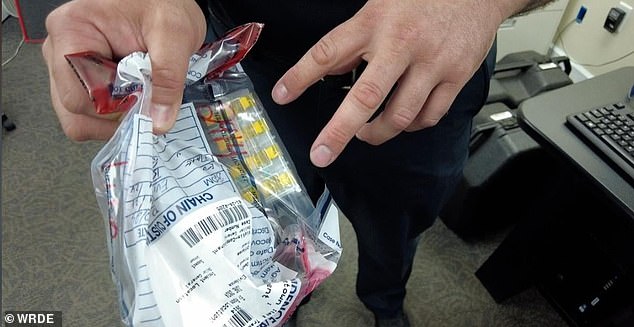Walmart self-checkout scam lasted 18 days before being spotted – here’s how you can protect yourself
Police have issued an urgent warning for self-checkout machines after a scam went undetected for 18 days.
The criminals had placed a skimming device — disguised as a PIN machine — in the self-service aisle of several stores in Cromwell, Connecticut.
Two men are being prosecuted for fraud, WFSB reported. It’s the latest example of a disturbing new scam at self-checkout machines — a new version of a tried-and-true trick that’s been used at ATMs for decades. There was a similar case recently at a Kroger.
Card skimmers, which fraudsters often hide in ATMs and ticket machines, steal information such as card numbers and PIN codes from credit and debit cards.
With this information they can create counterfeit cards or use the information for online purchases, without the owner’s permission.
Two Walmart stores have recently been targeted by scams


Cromwell police have released images of the two suspects installing the devices
In one incident, police received a complaint from Walmart on July 17 after employees discovered a card skimmer on one of the checkout machines.
After staff reviewed the store’s security footage, it was discovered that the criminals had placed the skimmer on the cash register on June 29, some 18 days earlier.
“It has been further determined that the suspects are also responsible for attaching credit card skimmers to cash registers in retail stores throughout the state,” Cromwell police said in a statement Tuesday.
Cromwell police have also released images of the two suspects, who are still being sought.
According to police, suspects matching a description were also caught on security camera footage installing skimming equipment onto machines at nearby LaBonne’s Markets in Prospect.
Devices were also found in the registers of Big Y’s Naugatuck and Plainville locations, which had been installed on June 29.
On July 17, another device was found at the Walmart in Naugatuck.
“Providing customers with a safe shopping experience is our top priority,” Walmart said in a statement.
“We are continually evaluating our protocols and adding enhanced security measures to better protect in-store transactions,” the statement said.
Last month, a skimming device was also discovered in Georgetown, Delaware.
According to local authorities, the device went unnoticed by customers and staff for about ten days.
“It’s horrible. I didn’t believe it would actually happen and then you hear it on the news,” Georgetown resident Virginia Layfield told Coast TV news.
“You know, you don’t know what can happen overnight in such a small area like this,” she said.
The device was only discovered and reported to police when a customer noticed fraudulent charges on his card, Coast TV reported.
“We are reaching out to our partners at the FBI to see if we can do facial recognition, to see if it is part of a larger group,” Georgetown Police Lt. Matthew Barlow told the outlet.

The skimming device found at Walmart in Connecticut
“When we talk about fraud of this nature, oftentimes it can be that electronic fraud and things like that are part of a larger organization. It may be something that our partners, the FBI or the Secret Service, are already investigating. We want to be helpful in that regard and of course take care of our victims locally,” he added.
How to prevent skimming fraud
Dr. Vahid Behzadan, assistant professor of computer science at the University of New Haven, told WFSB that one of the best ways to protect yourself from this type of fraud is to use contactless cards or Apple Pay, which don’t require you to insert a card into a machine.
Behzadan also advises staying vigilant and trying to detect anomalies by touching the card reader, regularly checking credit card payments for unusual transactions, and even setting up transaction notifications on a smartphone.
